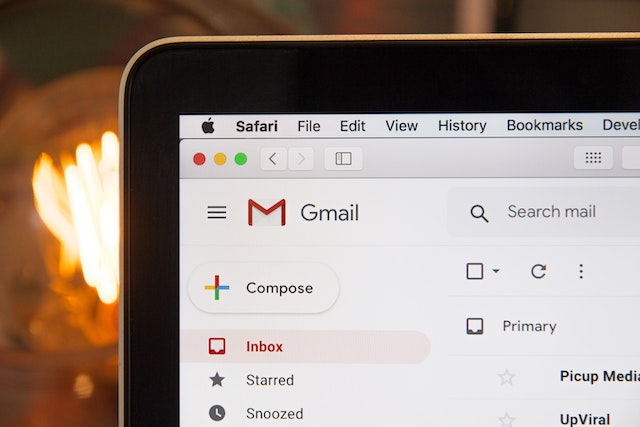
Like a nice pair of jeans, email marketing never goes out of style. And whether you publish traditionally, independently, or in a hybrid model, email can help you sell more books.
In this article, we’ll cover the necessary steps to getting started with email marketing.
Start With Your Service
Though personal email services like Gmail and Yahoo Mail are great, they aren’t suited to sending hundreds (or even thousands!) of emails at once. You’ll need an email marketing service for that task.
There’s no shortage of options. MailChimp is perhaps the best known, but there’s also SendGrid, Constant Contact, Campaign Monitor, and more. If you have the time and inclination, I suggest researching your options, both on company websites and with customer reviews.
However, if you’re looking for the easiest option to get started, I recommend MailChimp. It’s a relatively intuitive service with plenty of options for authors, no matter how large or small your audience. Plus, it boasts an advantage few of its competitors do: it’s free!
Well, to a point. MailChimp is free so long as you have fewer than 2,000 subscribers and send fewer than 12,000 emails per month. That’s perfect for most writers, especially if you’re just starting out.
Establish Your Address
This is an often overlooked step when it comes to email marketing, but it’s important. By law in most countries, if you’re going to send mass emails, you must list a physical address on each of those emails.
If you have a business address, you're set. If your office is your home, you’re free to list that address. But if you’re like me, you might not be comfortable slapping your home address onto communications for hundreds of people you don’t necessarily personally know. In that case, try a post office (PO) box.
I can’t vouch for the process in other countries, but here in the States, it’s relatively easy (paperwork notwithstanding). Once you’re assigned a box at your local post office, list that address in your emails.
Building Your List

Every email marketing list starts small. My list, for instance, began with a single address: my own!
Proceed by asking people in person if they’d like to join. That means friends and family (unless you don’t mind approaching randos on the street). Tell them what you’re creating and ask them if they’d like to receive it. It might feel like cheating if several early subscribers have the same last name as you, but again, everyone starts somewhere.
Next, create a place where new subscribers can sign up. If you already have a website or blog, you can embed a sign-up form into any given page. If not, no worries. Most email clients support landing page creation.
Once you’ve perfected your sign-up form, share it everywhere you can think of: social media, your blog, your Amazon author page, etc.
Even after taking these steps, your subscriber count might seem low. Don’t worry! In my experience, email lists grow slowly but steadily. It’s rare to see a huge spike in one day. Rather, most lists trend steadily upward. Keep at it!
Email Content
Content is, and always will be, the most important part of your email marketing.
If you’re unsure how to begin, here’s a sample newsletter arrangement:
- Brief introduction
- News
- Writing sample
- Reading update
- Links to recent blog posts
- Pet update
- Sign off
Another take: Treat each newsletter as a blog post. If you don’t already have a blog, this is a great way to go. I’ve seen writers delve into their process, provide details on their worlds, or even write from a character’s perspective.

You want to make sure that your email marketing is showcasing your work in the best way possible, and nothing makes a writer lose credibility faster than spelling or grammar mistakes. I run all of my marketing emails through ProWritingAid in my browser, which not only ensures that my writing is error free, but also improves the clarity and power of my marketing emails by offering style suggestions, readability reports, and loads of other useful features. I wouldn't send an email without it!
With your emails, experiment and iterate. Check your open, click, and engagement rates about a week after each email sends. See which subjects resonate and which don’t. Replicate the successful experiments, then tweak or abandon the unsuccessful ones.
I’ll give you a personal example. My wife and I recently got a puppy. Therefore, in my next newsletter, I used “The puppy edition“ as the subject line. This email had a 36.5% open rate, which is far higher than my average. It’s a limited sample size, but I think we can safely assume that my subscribers like puppies. I'll be sure to add the pup to future newsletters.
The Reader Magnet
This is a term I first heard from Jeff Goins, but I’m sure others have introduced similar concepts.
Here's the gist: people get a lot of emails. So many, in fact, that we should offer subscribers something in return for their address. Enter the reader magnet.
If you’re a fiction writer, your reader magnet might be a short story set in the world of one of your novels. If you’re a non-fiction writer, your reader magnet might be your condensed manifesto. Whatever you choose, make sure it’s, well, magnetic! Clearly explain your offer, then create an automation that sends the product whenever people subscribe. It’s a tried-and-true method for building your email marketing list.
Parting Thoughts
Email marketing is still one of the most useful and productive ways an author can contact their readers. It’s worth it for any writer to invest in this form of marketing. So please do so! Use these tips, and enjoy.


